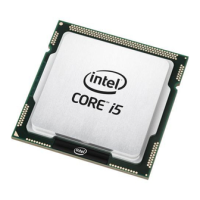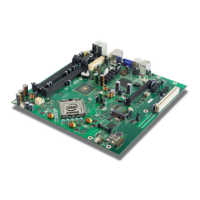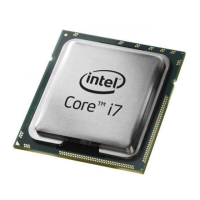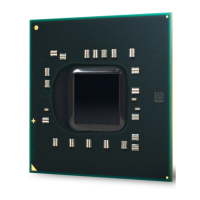Intel
®
Celeron
®
D Processor in the 775-Land LGA Package Thermal Design Guide37
Order #303730
LGA775 Socket Heatsink Loading
Appendix A LGA775 Socket Heatsink Loading
A.1 LGA775 Socket Heatsink Considerations
The heatsink clip load is traditionally used for:
• Mechanical performance in shock and vibration.
— Refer to the Intel Pentium 4 Processor on 90nm Process in the 775-Land LGA Package
Thermal Design Guide for information on the structural design strategy for the Intel
RCBFH-3 Reference Design heatsink.
• Thermal interface performance:
— Required preload depends on TIM.
— Preload can be low for thermal grease.
In addition to mechanical performance in shock and vibration and TIM performance, the LGA775
socket requires a minimum heatsink preload to protect against fatigue failure of socket solder
joints.
Solder ball tensile stress is originally created when, after inserting a processor into the socket, the
LGA775 socket load plate is actuated. In addition, solder joint shear stress is caused by coefficient
of thermal expansion (CTE) mismatch induced shear loading. The solder joint compressive axial
force (F
axial
) induced by the heatsink preload helps to reduce the combined joint tensile and shear
stress.
Overall, the heatsink required preload is the minimum preload needed to meet all of these
requirements: Mechanical shock and vibration and TIM performance and LGA775 socket
protection against fatigue failure.
A.2 Metric for Heatsink Preload for Designs
Non-Compliant with Intel Reference Design
A.2.1 Heatsink Preload Requirement Limitations
Heatsink preload by itself is not an appropriate metric for solder joint force across various
mechanical designs and does not take into account:
• Heatsink mounting hole span
• Heatsink clip/fastener assembly stiffness and creep
• Board stiffness and creep
• Board stiffness modified by fixtures like backing plate, chassis attach, etc.
Simulation shows that the solder joint force (F
axial
) is proportional to the board deflection
measured along the socket diagonally. The matching of F
axial
required to protect the LGA775
socket solder joint in temperature cycling is equivalent to matching a target MB deflection.
Therefore, the heatsink preload for the LGA775 socket solder joint protection against fatigue
failure can be defined as the load required to create a target board downward deflection throughout
the life of the product.

